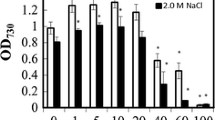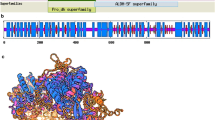Abstract
Alcaligenes spec. strain GL (IMET 11314) is able to grow on glyphosate (N-[phosphonomethyl]glycine) and other phosphonates as sole source of phosphorus. Degradation of glyphosate to inorganic phosphate and sarcosine by this strain is subject to several regulatory principles. While uptake and dephosphonation of glyphosate are regulated by Pi starvation, the intensity of glyphosate degradation is also controlled by the cellular ability to utilize the C-skeleton derived from glyphosate. Depending on the external concentration of glyphosate, the liberated sarcosine is differentially metabolised. Utilization of the sarcosine moiety and complete incorporation of 3-[14C]-label of glyphosate into cellular material occur only in cultures adapted to higher concentrations (5 mM) of the herbicide. At low concentrations of glyphosate (1 mM) only the Pi required by the growing cultures is utilized but not the sarcosine. Initially high rates of glyphosate uptake obtained after Pi-starvation decrease in the presence of low glyphosate concentrations. It is suggested that uptake and metabolism of glyphosate are connected with the expression of the sarcosine metabolizing capacity of the Alcaligenes cells.
Similar content being viewed by others
Abbreviations
- AMPA:
-
aminomethylphosphonic acid
References
Balthazor TM, Hallas LE (1986) Glyphosate degrading microorganisms from industrial activated sludge. Appl Environ Microbiol 51:432–434
Cook AM, Daughton CG, Alexander M (1978) Phosphonate utilization by bacteria. J Bacteriol 133:85–90
Cordeiro ML, Pompliano DL, Frost JW (1986) Degradation and detoxification of organophosphonates: cleavage of the carbon to phosphorus bond. J Am Chem Soc 108:332–334
Fitzgibbon I, Braymer HD (1988) Phosphate starvation induces uptake of glyphosate by Pseudomonas sp. strain PG 2982. Appl Environ Microbiol 54:1886–1888
Issleib K, Balszuweit A, Mueller K, Moegelin WZ (1980) N-alkylaminomethanphosphonsaure-dialkylester via hexahydro-s-triazine. Anorg Allgem Chem U69:109–115
Kishore GM, Jacob GS (1987) Degradation of glyphosate via sarcosine intermediate. J Biol Chem 262:12164–12168
Jacob GS, Garbow JR, Hallas LE, Kimack NM, Kishore GM, Schaefer I (1988) Metabolism of glyphosate in Pseudomonas sp. strain LBr. Appl Environ Microbiol 54:2953–2958
Loo SH, Peters NK, Frost JW (1988) Genetic characterization of an Escherichia coli mutant deficient in organophosphonate biodegradation. Biochem Biophys Res Commun 148: 148–152
Mastalerz PZ, Wieczorek Z, Kochmann M (1965) Utilization of carbon-bound phosphorus by microorganims. Acta Biochim Pol 12:151–156
Moore IK, Braymer HD, Larson AD (1983) Isolation of a Pseudomonas sp. which utilizes the phosphonate herbicide glyphosate. Appl Environm Microbiol 46:316–320
Pipke R, Amrhein N (1988) Carbon-phosphorus lyase activity in permeabilized cells of Arthrobacter sp. GLP-1. FEBS Lett 236:148–152
Pipke R, Schulz A, Amrhein N (1987a) Uptake of glyphosate by an Arthrobacter sp. Appl Environ Microbiol 53:974–978
Pipke R, Amrhein N, Jacob GS, Schaefer J, Kishore GM (1987b) Metabolism of glyphosate in an Arthrobacter sp. GLP-1. Eur J Biochem 165:267–273
Rippka R, Deruelles J, Waterbury JB, Herdman M, Stanier RY (1979) Generic assignments, strain histories and properties of pure cultures of cyanobacteria. J Gen Microbiol 111:1–61
Shinabarger PL, Schmitt EK, Braymer HD, Larson AD (1984) Phosphonate utilization by the glyphosate-degrading Pseudomonas sp. strain PG 2982. Appl Environ Microbiol 4:1050
Talbot HW, Lohnson LM, Munnecke DM (1984) Glyphosate utilization by Pseudomonas sp. and Alcaligenes sp. isolated from environmental sources. Curr Microbiol 10:255–260
Wackett LP, Shanes SpL, Venditti ChP, Walsh ChT (1987a) Bacterial carbon-phosphorus lyase: products, rates, and regulation of phosphonic and phosphinic acid metabolism. J Bacteriol 169: 710–717
Wackett LP, Wanner BL, Venditti ChP, Walsh ChT (1987b) Involvement of the phosphate regulon and the psiD locus in carbonphosphorus lyase activity of Escherichia coli K-12. J Bacteriol 169: 1753–1756
Author information
Authors and Affiliations
Rights and permissions
About this article
Cite this article
Lerbs, W., Stock, M. & Parthier, B. Physiological aspects of glyphosate degradation in Alcaligenes spec. strain GL. Arch. Microbiol. 153, 146–150 (1990). https://doi.org/10.1007/BF00247812
Received:
Accepted:
Issue Date:
DOI: https://doi.org/10.1007/BF00247812




